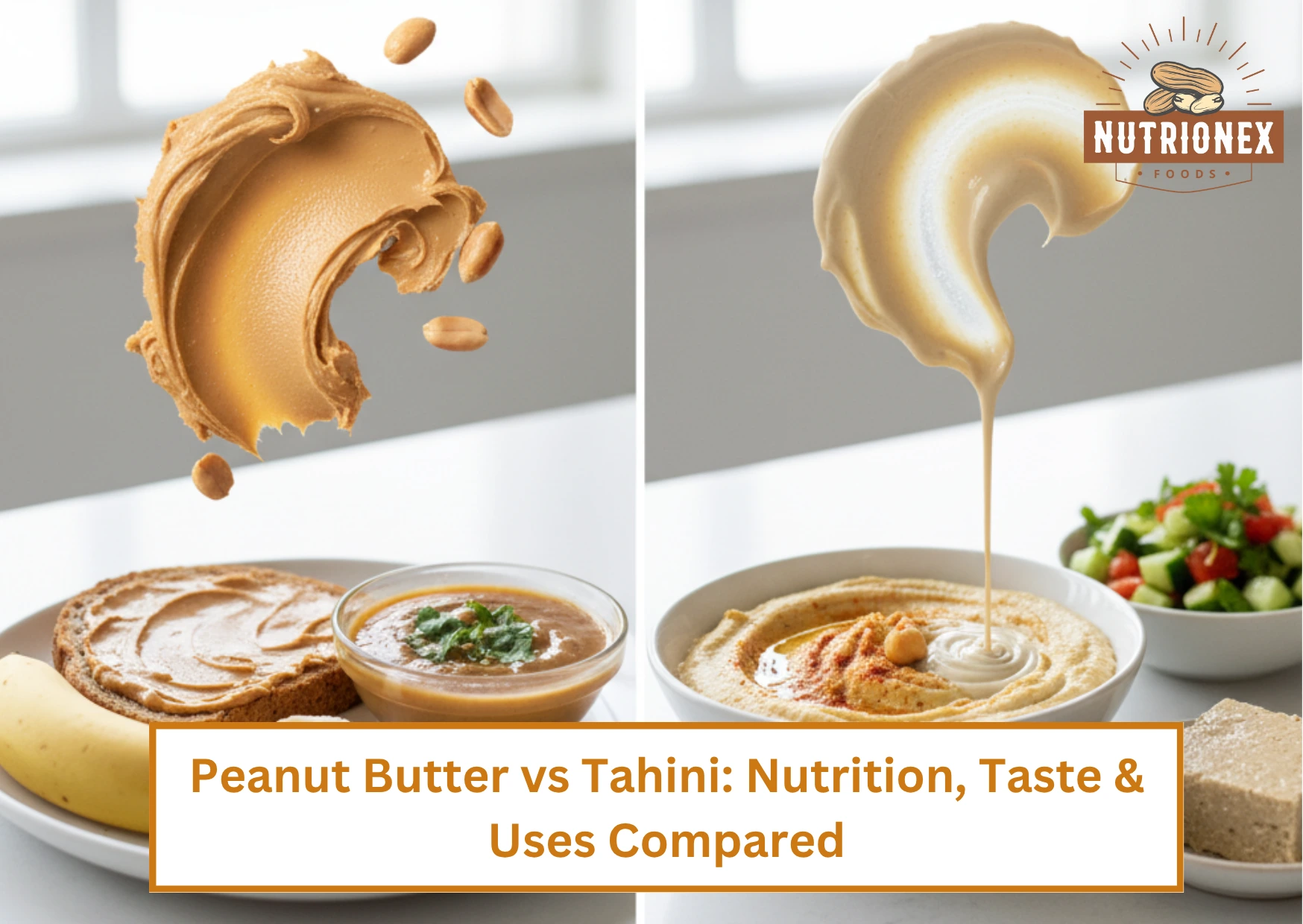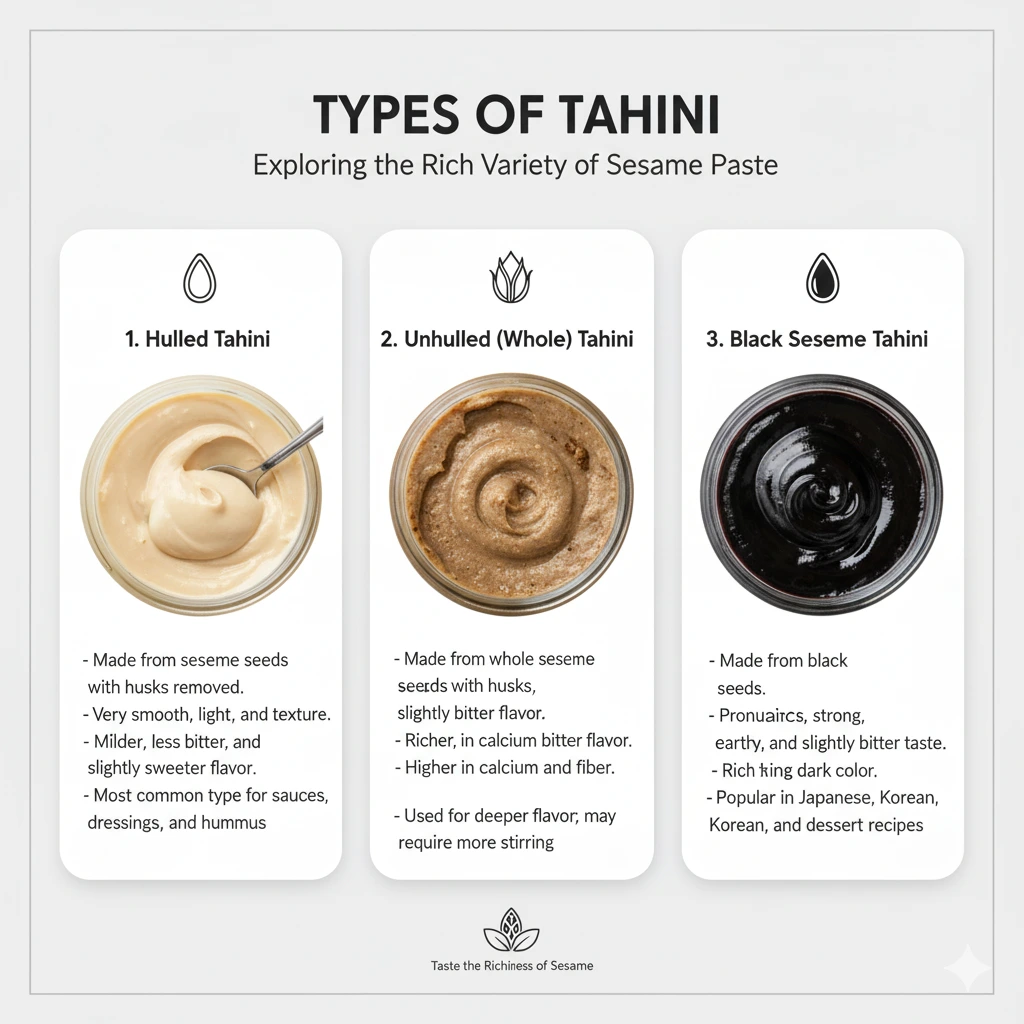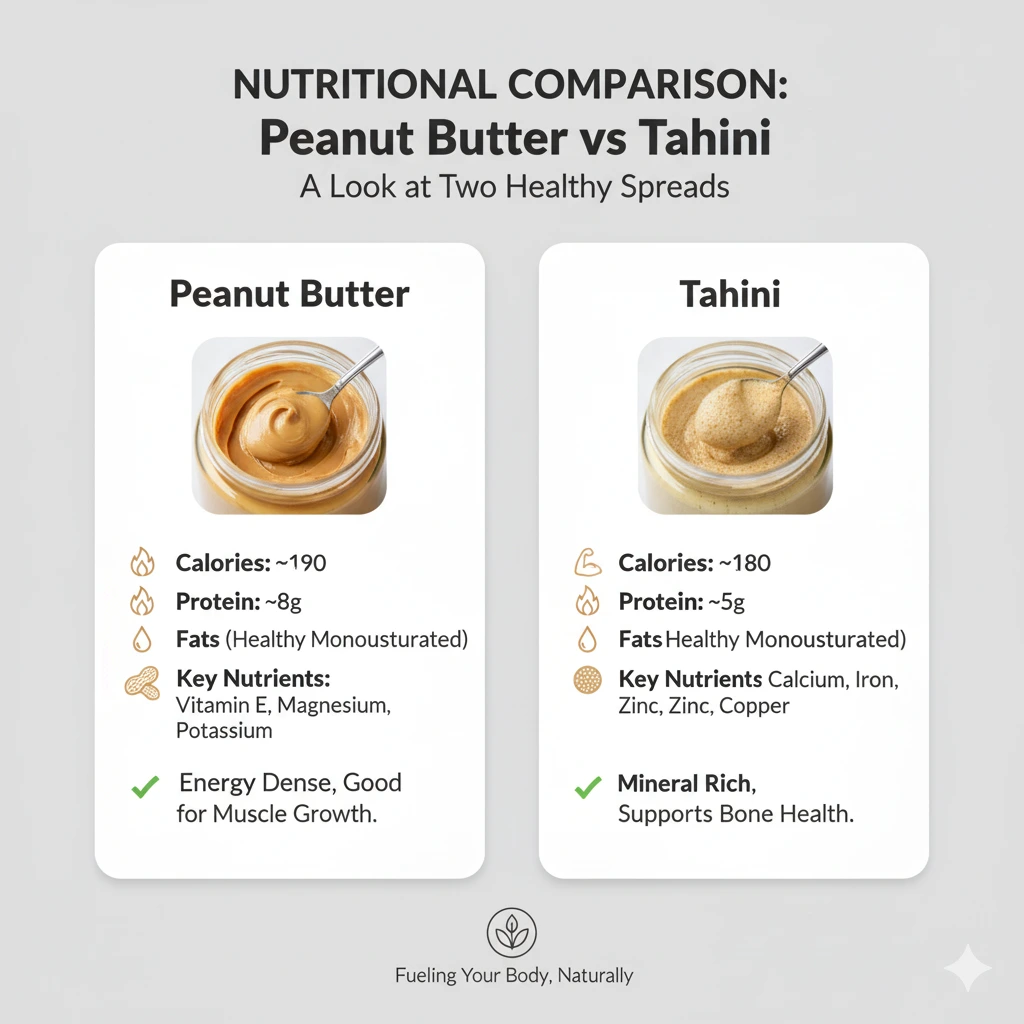
Peanut Butter Vs Tahini Butter: Nutrition, Taste & Uses Compared
Nut and seed butters have become a staple in modern kitchens, loved for their flavor, versatility, and nutritional profile. Among the most popular spreads, peanut butter & tahini butter often sparks debate among health enthusiasts, foodies, and house cooks. While both are creamy, flavorful, and loaded with nutrients, they differ significantly in texture, and health benefits. This blog writes about the differences to help you decide which fits best into your diet, recipes, and lifestyle.
Some people even conduct a taste test to compare sweetness, nuttiness, and overall flavor balance in their favorite recipes, helping them decide which spread fits better into their food choices.
What is Peanut Butter?
Peanut butter is a beloved spread made by grinding roasted or raw peanuts into a smooth or chunky paste. Traditional peanut butter often contains peanuts, without sugar, palm oil, or salt. Peanut butter is commonly sold in a jar, making it convenient for storage and use.
Types of Peanut Butter:
-
Natural Peanut Butter: Made with minimal processing, containing mainly peanuts and without added sugar and pinch of salt.
-
Creamy vs Chunky: Creamy peanut butter pastes easily on toast or bread, while chunky varieties provide a satisfying nutty crunch.
Nutritional Overview
Peanut butter jar is loaded with protein, healthy fats, and fiber, making it an ideal spread for kids and adults alike. When included as part of a balanced diet, peanut butter can be beneficial for health. It also contains oleic acid, that supports cardiovascular health. Typical servings provide:
-
Protein: 7–8 g per 2-tbsp serving
-
Fat: 16 g
-
Carbs: 6 g
-
Vitamins & minerals: Vitamin E, magnesium, and potassium
Beyond nutrition, peanut butter is the key ingredient in cookies, smoothies, and countless recipes around the globe.
What is Tahini?

Tahini is a creamy paste made from sesame seeds, widely used in Middle Eastern and Mediterranean cuisines. Tahini is known for its distinct flavors, featuring nutty, earthy, and slightly bitter notes that set it apart from other spreads. Unlike peanut butter, tahini has a more earthy flavor and thinner consistency, though it can also be smooth or slightly coarse depending on preparation.
Types of Tahini:
-
Raw vs Roasted Sesame Seeds: Roasting intensifies flavor and aroma.
-
Hulled vs Unhulled: Hulled seeds produce a smoother paste, while unhulled seeds increase fiber and nutrients.
-
Common Uses: Tahini is used in hummus, dressings, sauces, and cooking various traditional and modern recipes.
Nutritional Overview
Tahini is rich in protein, healthy fats, and essential minerals like calcium, magnesium, and iron. A typical 2-tbsp serving offers:
-
Protein: 5 g
-
Fat: 16 g
-
Carbs: 3 g
-
Minerals: calcium, iron, and antioxidants
Beyond nutrition, peanut butter is the key ingredient in cookies, smoothies, and countless recipes, especially those that include almonds for added crunch and nutrition.
Eating peanut butter regularly in moderation can support satiety and energy levels. For those eating plant-based diets, pairing peanut butter with fruits or oats makes a quick, nutrient-rich meal.
Nutritional Comparison: Peanut Butter vs Tahini
| Nutrient | Peanut Butter | Tahini |
|---|---|---|
| Calories | High | Moderate |
| Protein | High | Moderate |
| Fat | Rich in oleic acid (healthy monounsaturated fat) | Mainly polyunsaturated fats |
| Fiber | Moderate | Higher |
| Vitamins & Minerals | Contains Vitamin E, magnesium | Contains calcium, iron, antioxidants |
| Sugar | No added sugar | May contain added sugar |
Both spreads are nutrient-dense, but peanut butter offers slightly more protein, while tahini excels in minerals like calcium. Choosing between them depends on your health goals, taste preference, and intended cooking applications.
After considering the nutrition, it's important to note that both spreads carry a risk of allergic reactions. Additionally, some peanut butters may contain substances like aflatoxins or added ingredients that could pose health risks. Choosing natural brands that avoid unnecessary additives helps reduce this risk.
Taste & Texture Comparison

Peanut butter and tahini reveals unique characteristics:
-
Peanut Butter: Sweet, nutty, roasted flavors. Available in creamy or crunchy textures, making it ideal for snacks and desserts.
-
Tahini: Earthy, slightly bitter flavors and smooth texture; works well in hummus, sauces, and dressings.
Taste is a key factor in pairing: peanut butter suits sweet dishes, while tahini excels in savory or Middle Eastern recipes. Some adventurous cooks combine both in innovative recipes to balance sweetness and nuttiness.
Culinary Uses
Both spreads are versatile in cooking and baking, but their applications differ:
Peanut Butter Uses:
-
Spread on toast, sandwiches, or crackers.
-
Key ingredient in cookies and other baked goods.
-
Added to smoothies, snacks, and sauces.
-
Mixed in stir-fry sauces for Asian-inspired food recipes.
Tahini Uses:
-
Foundation for hummus and dips.
-
Mixed in salad dressings, sauces, or roasted vegetables.
-
Used in Middle Eastern desserts like halva.
-
Can replace peanut butter in some recipes for a different flavor.
Pro Tip: Try combining peanut butter and tahini in smoothies or energy bars for a creamy, nutrient-packed spread.
Peanut butter and tahini can work wonders in both sweet and savory food recipes, enhancing flavor and texture.
Health Benefits
Both nut butters offer several benefits:
-
Heart Health: Rich in healthy fats like oleic acid and polyunsaturated fats.
-
Rich Source: Peanut butter is protein-rich; tahini also contributes protein to a plant-based diet.
-
Minerals & Vitamins: Tahini provides calcium, iron, and magnesium; peanut butter offers vitamin E and magnesium.
-
Antioxidants: Tahini contains antioxidants that combat oxidative stress.
-
Weight Management: Both Pastes can help in satiety and eating control when consumed in moderation.
Research supports the health benefits of peanut butter and tahini, highlighting their antioxidants and healthy fats as Good for heart health and overall wellness.
Which Should You Choose?
The choice between peanut butter and tahini butter depends on your diet and intended use:
-
For Protein: Choose peanut butter, ideal for kids and fitness enthusiasts.
-
For Minerals: Tahini is rich in calcium, iron, and antioxidants.
-
For Taste: Peanut butter for sweet dishes; tahini for savory meals.
-
For Baking: Peanut butter cookies are classic; tahini adds a unique nutty flavor to desserts.
Families often feel decided between choosing peanut butter or tahini based on taste preferences, but both are equally nutritious staples.
Tips for Buying and Storing
-
Natural peanut butter: look for brands with only peanuts and minimal other ingredients. Avoid peanut butter brands with added sugar, palm oil, or other unnecessary ingredients.
-
Tahini: choose hulled seeds for smooth texture and roasted seeds for enhanced flavor.
-
Storage: both jars should be kept in the pantry or fridge to maintain freshness and texture. There are budget-friendly options available for both peanut butter and tahini, though these may differ in quality or flavor.
Keeping these spreads in your kitchen ensures you always have a staple ingredient ready for sandwiches, smoothies, or family meals.
Find Your Perfect Peanut Butter
Conclusion
In the debate of peanut butter vs tahini, there is no absolute winner. Both are delicious, versatile, and nutritious. Peanut butter is perfect for smoothies, snacks, and baking, while tahini is ideal for savory dishes, hummus, and mineral-rich meals. Experiment with both spreads in your kitchen to enjoy their flavor, texture, and numerous benefits.
Whether you enjoy almond butter, peanut butter, or tahini, incorporating these nut butters into your diet can enhance your recipes and provide health benefits, and other essential nutrients in a tasty and satisfying way. Both are excellent staple foods that can be enjoyed by adults, children, and the whole family.
As a trusted manufacturer, we ensure that our peanut butter delivers consistent quality, natural taste, and the nutritional goodness your body deserves. Whether you’re enjoying it on toast, in desserts, or as part of your daily meal, peanut butter remains a wholesome and delicious staple that can easily fit into any lifestyle.
FAQs
1. What is the difference between peanut butter and tahini butter?
Peanut butter and tahini butter mainly differ in taste, texture, and source. Peanut butter is made from peanuts without added sugar and other ingredients, while tahini is a seed butter made from sesame seeds. Peanut butter tends to be sweet and creamy or chunky, whereas tahini has a nutty, slightly bitter flavor and smooth texture.
2. Is natural peanut butter healthier?
Yes, natural peanut butter is generally healthier because it contains peanuts and no use of other ingredients.
4. How do the nutritional benefits compare?
Both Pastes offer excellent health benefits:
-
Peanut butter is rich in protein, oleic acid, and fiber.
-
Tahini provides calcium, iron, and antioxidants.
Both are energy-dense and ideal for snacks, smoothies.
5. Which is better for kids and family snacks?
Peanut butter is popular with children and kids due to its sweetness and versatility in recipes. Tahini, though less sweet, is a great option for introducing nut and seed butters rich in protein.
Both can be used in sandwiches, dips, and quick snacks.
6. Can I substitute almond butter or other nut butters?
Yes, almond butter or other nut butters can substitute either peanut butter or tahini in certain recipes, though taste and texture may vary. Almonds provide a milder flavor and slightly different nutrient profile, including healthy fats.
7. Should I store peanut butter or tahini in the fridge?
It depends on the brand and type. With natural peanut butter and tahini, you may notice oil sitting on top of the jar this is normal and can be stirred back in. Stirring and refrigerating can maintain texture and freshness. Creamy or smooth pastes tend to stay stable longer in the pantry, but refrigeration helps extend shelf life, especially for natural spreads.
9. How can I use both in cooking and baking?
-
Peanut butter is ideal for cookies, smoothies, sauces, and spreads.
-
Tahini is perfect for hummus, dressings, and Middle Eastern recipes.
Both are versatile in cooking, adding flavor to meals. You can even combine both for a delicious twist in baked goods or savory sauces.
10. What is the serving size and calorie content?
A standard serving is about 2 tablespoons, providing roughly 180–190 calories. Both pastes are nutrient-dense, so mindful eating is recommended, especially when making snacks or desserts.
